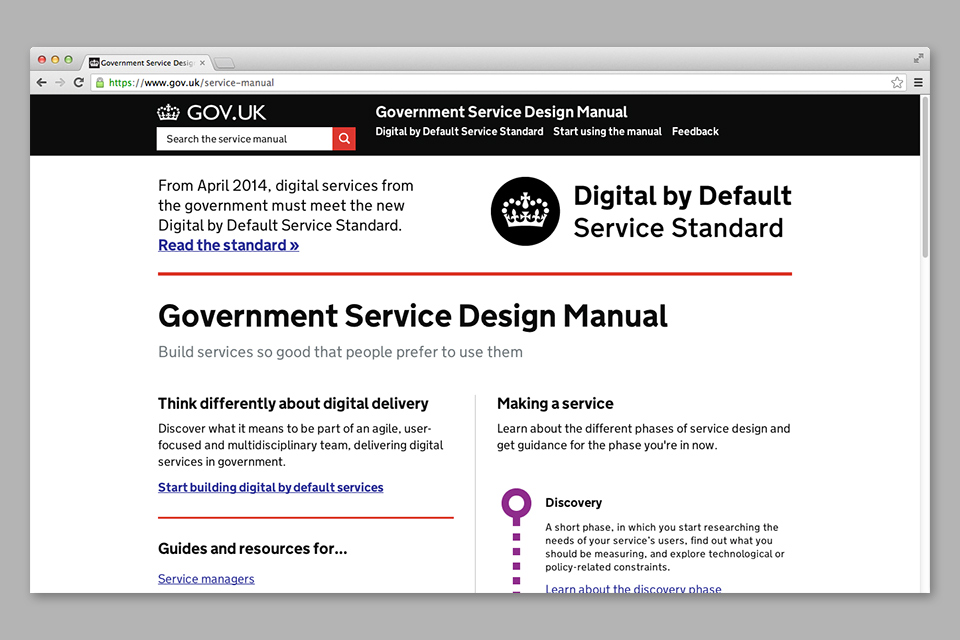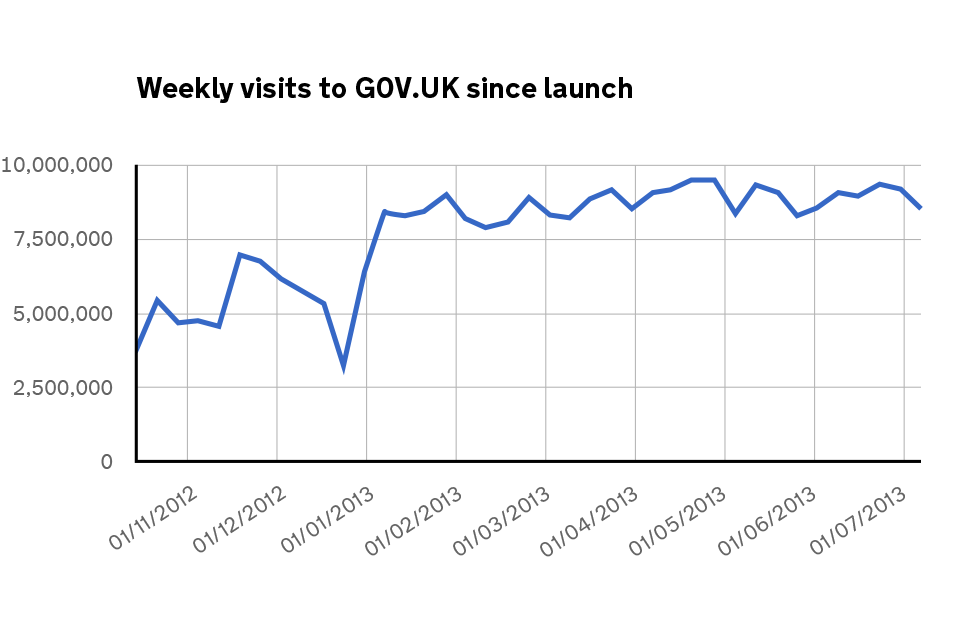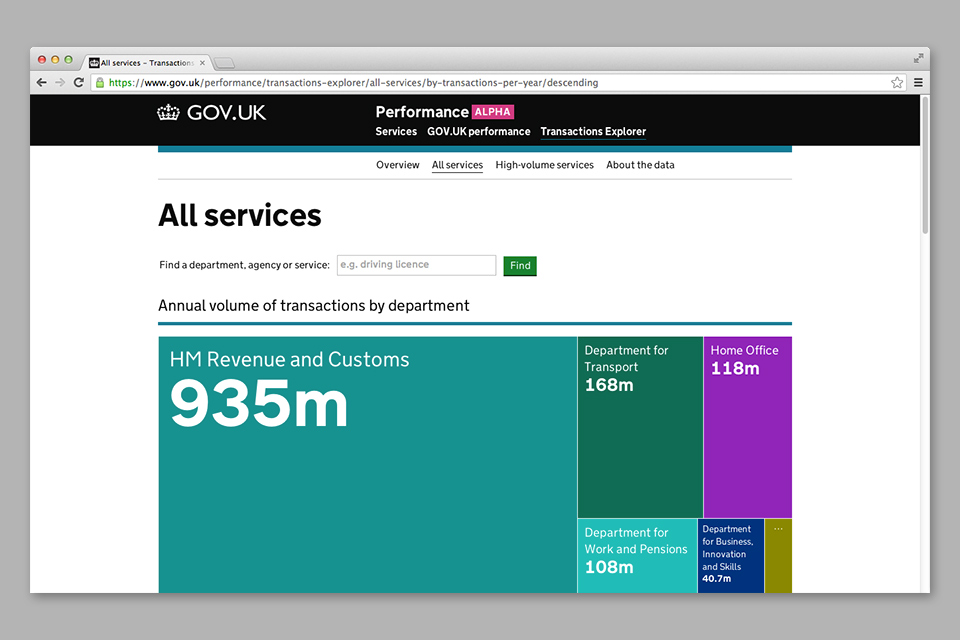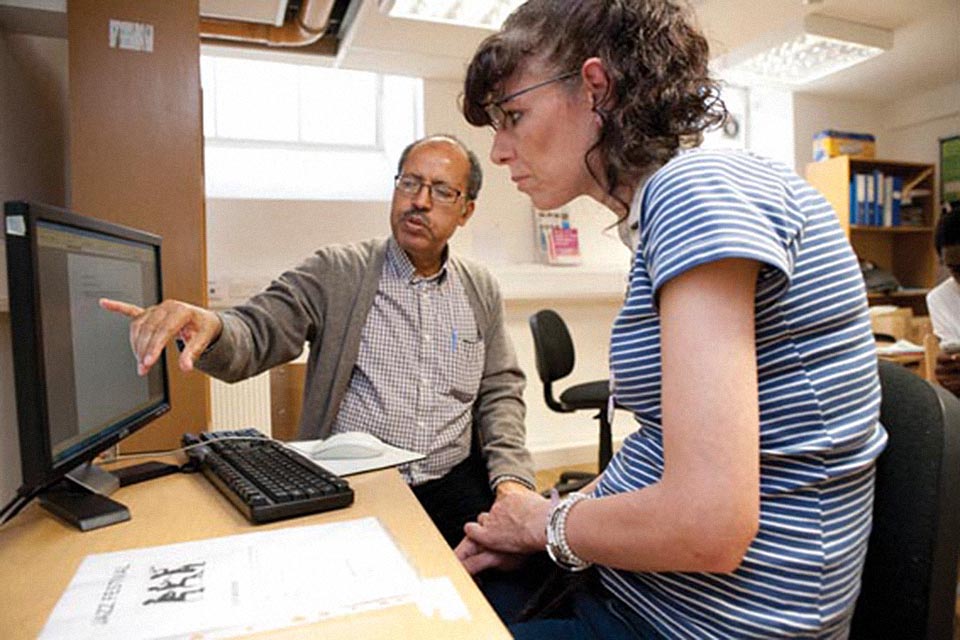Government Digital Strategy: quarterly progress report July 2013
Published 4 December 2013
The Government Digital Strategy was published in November 2012. It included a list of 14 actions for redesigning government digital services to make them so straightforward and convenient that all those who can use them prefer to do so. Each government department apart from Department for Communities and Local Government (DCLG) has its own digital strategy, setting out what it will do to respond to those actions.
Every 3 months, we publish a short summary of what’s been done. This is the second of those reports; the first was published in April 2013.
From awards to transactions
Mike Bracken introduces the July 2013 quarterly report
We’re pushing on with implementing the Government Digital Strategy; the National Audit Office (NAO) report, Digital Britain 2, commented that the digital agenda had firm leadership and was based on sound evidence.
GOV.UK is an award-winning website and continues to grow, but now our primary focus is on digital transformation - rebuilding government services for the way people live today. We’ve started work on redesigning 25 of the biggest and most-used transactional public services - we call them exemplars, leading the way for others to follow. Since April, we’ve done a great deal of work, often behind the scenes, and confirmed multi-million pound cost savings. We haven’t got as far as we would have liked; some projects were delayed because of difficulties in resourcing, which meant we didn’t have enough people to do all the work. That’s something we’re already tackling. There’s still a huge amount of work to do but we hope to make up for lost time through the rest of the year.
There’s more detail in the report below, but at a quick glance, in the 3 months between April and June, we:
-
provided help to departments as they recruit and train the skilled people they need; so far we’ve recruited to 11 digital specialist posts for DWP, been involved in recruitment processes for 29 senior technology posts, started running an induction and development programme for Service Managers and advised 3 of the 7 major transactional departments on organisational design needed to make digital transformation happen
-
published the Digital by Default Service Standard and its accompanying manual
-
moved the 25 digital exemplars forward; by the end of June, 13 were in discovery phase, 6 were in alpha, 5 in beta, and elements of 1 were live
-
moved 6 more ministerial department websites to GOV.UK, and started work on moving across 300 more websites of other government agencies and public bodies
-
won 2 prestigious national awards for GOV.UK design and content
-
continued work on a series of government-wide technology and policy platforms (in areas such as assisted digital, identity assurance, transaction and performance data, digital engagement and open policy making)
-
announced that Her Majesty’s Revenue and Customs (HMRC) would be the first government department to use the new Identity Assurance reference hub, from autumn onwards
-
published an updated version of identity principles for consultation
-
started reviewing the way in which we run and use technology government-wide
-
announced a new cross-government approach to digital inclusion
-
announced savings of £500m, mostly as a result of IT spend controls and moving government services and transactions to digital platforms. Of that, £42m was the result of replacing Directgov and BusinessLink with GOV.UK.
In the next 3 months (July to September 2013), we plan to:
-
move more than 30 agency and arms length body websites across to GOV.UK
-
continue work on all 25 exemplar services moving 2 more into beta including Lasting Power of Attorney and 1 into alpha. This includes joint DWP/GDS work to explore enhancing the IT for Universal Credit to make use of advances in technology since the current system was developed
-
invite suppliers to help us deliver the digital agenda through a new procurement framework
-
create an online library of best practice case studies to help departments with digital policy-making
-
set up the new digital inclusion team within GDS, and start work on a digital inclusion strategy and on identifying opportunities for partnerships between the public, private, voluntary and community sectors to help people get online
-
help departments find specialist digital and technology staff from inside and outside government through a Recruitment Hub based in GDS
-
take our Service Manager induction programme live, and integrate digital into existing training for senior civil servants
Digital capability and leadership
Government Digital Strategy case study on in-house digital capability
The Civil Service Capabilities Plan, published in April, identified digital capability (in other words, having civil servants who understand how digital can improve policy outcomes and know how to build, maintain and run digital services) as a high priority. Government Digital Service (GDS) has helped by:
-
advising departments (including the Department for Work and Pensions (DWP), HMRC, and the Home Office) on how to recruit senior people with the right digital and technology skills, and integrate those roles with the rest of the team
-
running an alpha of the Service Manager induction and development programme and using what we’ve learned from it to build a beta version for July
-
making 4 videos for civil servants, explaining the ways digital technology is already being used to transform services
The Ministry of Justice (MOJ) has appointed a new Digital Leader. All key agencies within the Department for Business, Innovation and Skills (BIS) now have digital leaders, half of them at Board level. BIS has also completed its own digital capability review.
Other departments are working on building their own teams:
-
The Foreign and Commonwealth Office (FCO) is setting up a team covering portfolio management, product management, training and digital policy development
-
Department for Energy and Climate Change (DECC) has established a small team to work on digital programme management, capability building, and service design and delivery
-
Ministry of Defence (MOD), Department of Health (DH) and Department for International Development (DFID) are setting up new roles or repurposing existing job descriptions
-
DCLG, DH and Department for Culture, Media and Sport (DCMS) are planning digital skills training for staff. DCMS is doing this alongside work on a new intranet built using agile thinking at a fraction of the cost of the site it replaces
Following the closure of the cross-government Chief Information Officer (CIO) and Head of Profession for ICT positions, GDS has started reviewing the best ways to run and use technology, interviewing senior leaders across government and the private sector to find out what works for them and how it might be put to use elsewhere.
The National Audit Office (NAO) report, Digital Britain 2, commented that government had established firm leadership of its digital agenda with its strategy based on sound evidence. NAO has been auditing issues such as building digital and technology capability in the Senior Civil Service, legacy ICT systems and the use of customer telephone lines in the context of an increasing digital by default approach to public service delivery.
Service design and operation

The Government Service Design Manual, published in mid-April, aims to help departments achieve the Digital by Default Service Standard. It got a positive reception, attracting attention internationally from both public and private sector organisations. Work continues on iterating and improving it in response to user feedback.
Meeting the Standard will be mandatory for all new and redesigned services handling over 100,000 transactions each year from April 2014. Initial assessment against the Standard has already started for new services applying to be made available via GOV.UK, looking at each one’s:
- fit with user needs
- capacity to develop and improve
- adherence to information security rules
Ten assessments have been done so far. Three services passed, subject to meeting certain requirements. These are: Academic Technology Approval Scheme (FCO), Cloudstore (Cabinet Office), and Office of the Public Guardian (MOJ). All services assessed so far began development before the Service Standard existed. Those needing to make further improvements before coming back for reassessment have been given detailed feedback on what work they need to do to achieve a pass.
Service transformations

The Government Digital Strategy asked departments to identify ‘exemplar’ services for transformation. We have begun work on all 25 exemplar services across 8 different departments. Progress has been good, but was held back by resourcing delays. Once discovery is complete we will have:
- the transformation strategy and business case for each service
- a way to review and revise what’s included in the exemplar work
- a delivery plan for each service and for the overarching GDS programme that will support this
Agile working methods are catching on within departments, most notably in Land Registry (where team members are going through certified training) and in Department for Environment, Food and Rural Affairs (Defra). Agile coaches are employed alongside a number of projects to complement the work of the GDS Transformation Team.
There are still issues to resolve across a number of departments around procurement support, IT provision and improving the rules we work within. To get the most from new digital services, they need to be developed as a part of wider business change, which is why we are looking at how organisational structures and culture need to adapt, alongside improving skills in the team.
The assisted digital team has started working with exemplar services (CAP Delivery, Lasting Power of Attorney, Civil Claims and Prisoner Visits Booking). They are gathering ideas for assisted digital provision in an open way, and collating data about user needs. There is an Assisted Digital Action Plan in the Service Manual to help with this. GDS held 2 events in June for potential providers from commercial and voluntary sectors, and Department for Transport (DFT), Defra, HMRC and DWP gave presentations. The assisted digital team is blogging regularly about its work.
Service redesign is not just for exemplars. Other departments are transforming services they identified in their departmental strategies. Examples include:
- the Development Tracker by DFID, released in beta in June, using open data to allow people to view information about UK development projects (including documents and detailed financial transactions)
- Crisis Hub, being developed as an agile project to support FCO’s crisis response- the supplier is an SME procured through the G Cloud framework
GOV.UK

All ministerial departments have now moved their corporate information publishing across to GOV.UK. Usage of GOV.UK rose steadily. Average daily visits exceeded 1.3 million throughout April.
Also in that month, GOV.UK was awarded the prestigious Design of the Year award. Judges unanimously voted for GOV.UK for its “well thought out, yet understated design”. This was followed in June by GOV.UK winning a both a yellow pencil and the coveted black pencil at the Design and Art Direction (D&AD) awards.
We improved search on the site, based on user feedback, behaviour analytics, and different user needs.
Work began to move agency and arm’s length body websites across to GOV.UK. Despite some delays around 15% of these sites have already been moved across.
Other government-wide initiatives supporting departmental digital work

New common platforms are being developed:
-
Transactions Explorer had its second release, with updated data on over 600 transactions across government. It now contains data on digital take-up as well as additional data on the 70 highest volume services, showing some of the key performance indicators used to assess transactional services.
-
The Performance Platform was released, with dashboards for all the different licences, notices, and registrations that people and organisations can apply for. These will be the first of many similar platform services.
-
The GOV.UK blogging platform was launched, initially featuring a ‘history of government’ blog operated by The National Archives. Existing blogs will soon be migrated to the new platform.
The Identity Assurance Programme is:
-
working with 9 central government departments and over 20 services
-
talking to other service providers interested in learning more (such as Money Advice Service, the Welsh and Scottish Governments, and several local authorities)
HMRC announced that it would be the first government department to use the new Identity Assurance reference hub for the PAYE Online exemplar service, launching in October 2013.
In June, the Identity Assurance Privacy and Consumer Advisory Group published an updated version of identity principles which focus on privacy and consumer expectations of users.
GDS has been working with departments to help them deliver technology to best support the digital agenda. For example, we are helping MOJ with recruitment, capability assessment and their End User Device procurement. They are now organising an event in Tech City to encourage new suppliers to come forward, potentially to support their rehabilitation revolution programme.
Departments agreed to highlight any legislative barriers that might get in the way of building digital processes and services. For example, requiring a “wet signature” on paper for citizens to get through some services. Departments are assessing whether and how these could be changed.
They are also exploring the use of digital tools to engage with the public and improve policy-making, and we are pulling together examples of ways to do it well.
Already:
-
DCLG launched an open policy-making project using social media channels to get public feedback on a range of campaigns, including ‘Fire Kills’ and ‘Right to Buy’.
-
DCMS trialled a blogging platform to talk to people about the Women’s Business Council Report. This was successful and will be used for future engagement projects.
-
The Digital Services Division within Ministry of Justice (MOJ) launched a live blog to highlight its work and invite discussion on it. This has been used in an open policy making exercise for the Criminal Justice System.
-
The Digital Communications Team within BIS is working to embed digital tools in the policy-making process. Early case studies were published in May on the digital@BIS blog.
-
FCO has shared case studies on how to use digital to improve foreign policy work on its digital diplomacy blog.
-
DH launched a beta version of its digital resource centre for policy-makers at Civil Service Live in July.
Digital inclusion

In mid-June, BIS released the Information Economy Industrial Strategy (IEIS) to boost growth for digital industries.
This announced that GDS will be the base for a new cross-government team to co-ordinate work to help people and businesses get online. It will:
-
develop a strategy for digital skills activity in central government, linked to digital inclusion work from elsewhere
-
act as a central point for collaboration on digital skills projects, and work with departments to build digital skills into the policy development process
-
build and maintain knowledge on ‘what works’ in digital inclusion, and use this for planning future activity
Other work to improve internet access is being undertaken by DCMS, where £680 million is being invested to make broadband faster and more reliable.
What’s the bottom line?
The Government Digital Strategy aims to improve services for people and save money at the same time. This quarter we announced that during 2012/13 we’d already saved about £500 million from IT spend controls and moving government services and transactions onto digital platforms. Of that, £42 million was saved by replacing Directgov and BusinessLink with GOV.UK.
